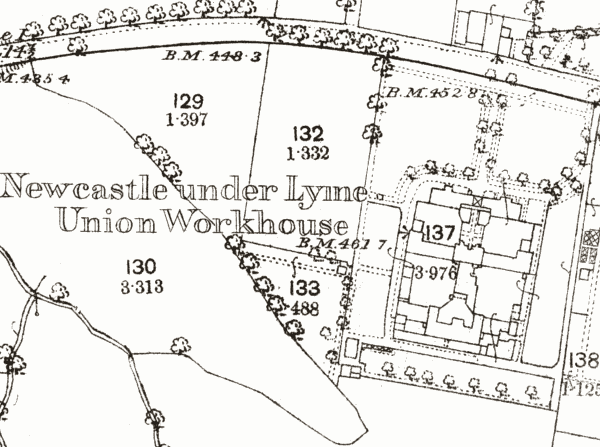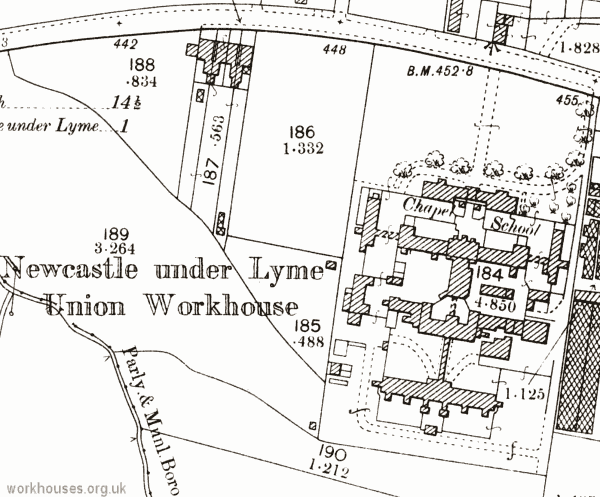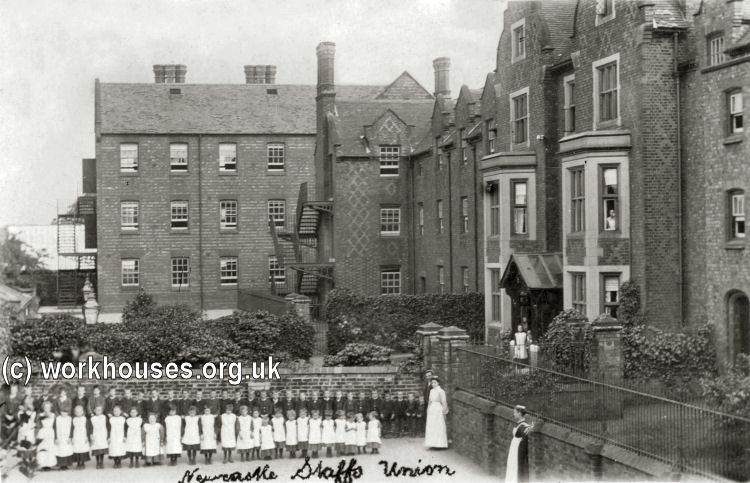Newcastle-under-Lyme, Staffordshire
Up to 1834
In 1731, the town's corporation resolved that 'the houses in Ireland [Higherland] be immediately repaired and converted into a workhouse'. The property in question was at the corner with Orme Road. One of the overseers was instructed to remove all the poor into the workhouse and to 'employ them in a proper manner and provide necessaries for them', for which he was to receive a salary of 4s. a week as master of the workhouse. In 1732 a George Alker was appointed to teach the poor to spin cotton.
Audley's workhouse was at the east what is now Alsager Road, about half way between Mill End Lane and Cross Lane. In 1777, it could accommodate 50 inmates. The property is now Old Workhouse Farm.
After 1834
The Newcastle-under-Lyme Poor Law Union formally came into being on 3rd April 1838. Its operation was overseen by an elected Board of Guardians, 18 in number, representing its 9 constituent parishes as listed below (figures in brackets indicate numbers of Guardians if more than one):
County of Stafford:
Audley (3), Balterley, Betley (2), Chapel Chorlton, Keele, Madeley (2), Maer, Newcastle-under-Lyme (6), Whitmore.
Later Additions: Clayton (from 1896), Hardings Wood (from 1894).
The population falling within the Union at the 1831 census had been 6,476 with parishes ranging in size from Whitmore (population 281) to Newcastle itself (8,192). The average annual poor-rate expenditure for the period 1835-37 had been £4,000 or 4s.10d. per head of the population.
Initially, the union took over the old Newcastle-under-Lyme parish workhouse. An inspection of the premises by by the guardians found the house to be 'extremely clean and well-regulated' with 'provisions of the best kind'. There were 64 inmates, 29 of them children, and the accommodation included 12 sleeping rooms, with 33 beds, a laundry, a bakehouse, stabling for a horse and a cow, and a recreation yard each for the men and the women. Following its replacement by a new building, the site went back into the corporation possession. In 1849, it was sold to Orme's Charity although later that year was used by the union to house patients during a cholera outbreak. The Orme English School, later the Orme Centre, now converted to flats was then erected on the site.
The new union workhouse was erected in 1838-9 at the south side of Keele Road to the west of Newcastle. It cost £6,000 and could accommodate 350 inmates. It was designed by the partnership of George Gilbert Scott and William Bonython Moffatt who were the architects of a large number of workhouses including those at Burton-upon-Trent, Lichfield and Uttoxeter.
Scott and Moffatt's design had similarities to their Lichfield building. It had an entrance range at the north with a central archway. The main building had a central portion containing the Master's quarters, with male and female accommodation to either side. To the rear was an E-shaped infirmary with a laundry at the female side and workshops at the male side. The workhouse location and layout are shown on the 1876 map below:

Newcastle-under-Lyme workhouse site, c.1876
Later additions included vagrant wards in 1878 and a new infirmary at the south in 1885-6 designed by John Blood. The old infirmary was then used as accommodation for the old and infirm. In 1890, the female wing was destroyed by a fire. It was rebuilt in 1894 at a cost of £11,000.

Newcastle-under-Lyme workhouse site, c.1900

Newcastle-under-Lyme workhouse, early 1900s.
© Peter Higginbotham.
After control of the site passed to the county council in 1930, consideration was given to turning the workhouse buildings into a hospital. However, this did not happen and the buildings were demolished in 1938.
Staff
Inmates
Records
Note: many repositories impose a closure period of up to 100 years for records identifying individuals. Before travelling a long distance, always check that the records you want to consult will be available.
- Staffordshire Record Office, Eastgate Street, Stafford, ST16 2LZ. Holdings include: Guardians' minute books (1837-1930); Ledgers (1843-1930); Relieving Officer's application and report books (1902-21); Returns of births and deaths (1894-1924); etc.
Bibliography
- Dinnacombe, Gladys (2017) A Staffordshire Workhouse: Living in the Workhouse of Newcastle Under Lyme
Links
- The union's early correspondence with the central poor-law authorities is online on the TNA website .
Unless otherwise indicated, this page () is copyright Peter Higginbotham. Contents may not be reproduced without permission.


